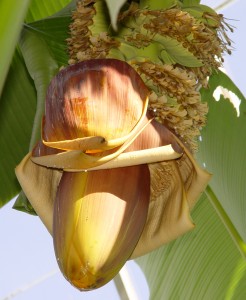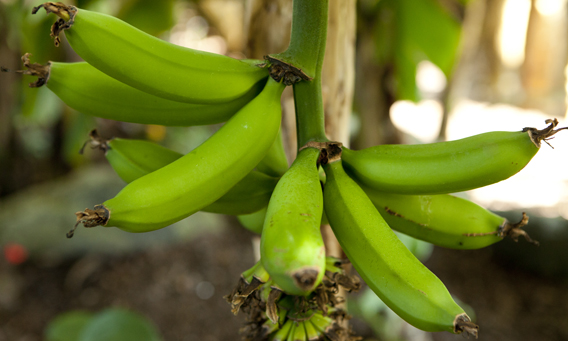Still Going Bananas
Posted in Gardening Tips on January 21 2014, by Sonia Uyterhoeven
Sonia Uyterhoeven is the NYBG’s Gardener for Public Education.

Continuing from last week’s discussion on growing bananas, I thought I would put together a few recommendations for over-wintering them in our neck of the woods. Just remember that if you are letting your banana go dormant for the winter, you need to cut back on the watering and fertilizing late in the growing season to ensure the plant begins its slow shut down. Towards the end of the season, give it a light pruning to remove some of the foliage.
If the banana is not hardy and has been planted in the ground, you’ll need to dig it up—either before the first frost or after a light frost. Keep the soil around the root ball and drop it into a snug plastic pot, then clean off any dead foliage you find. You can either cut the banana’s pseudostem back to 6 inches or leave the plant alone and let it dry out naturally. If you do the latter, you will be cutting it back in the spring.
Once you’ve got your banana in a pot, store it away in a dark, frost-free space until spring. The goal is to let it go dormant. You’ll also need to keep it on the cool side (below 55 degrees), and leaning toward dry. The banana will rot if it stays too wet. That said, you do not need to water the potted banana; just be sure to check on it occasionally so it doesn’t dry out completely.
That about covers overwintering for potted plants. For bananas that you would prefer to overwinter outside, choose one of the hardier varieties and mulch heavily with a combination of straw and leaves. The pile should create a 3-foot mound. For some of the less hardy species, growers should place approximately one foot of straw over the crown of the plant, then place a plastic sheet on top to prevent too much moisture getting in. Finally, cover the plastic with approximately 3 feet of straw or leaves. Make sure you use straw for your top layer, as it’s less likely to blow away during the winter. The pile should be much wider than the crown of the banana since the goal is to prevent the ground around the banana from freezing.
If you find yourself on a tropical mission to grow tall bananas that reach nearly their native size, you will need to wrap the pseudostem and let the plant overwinter in the ground. Let a light frost hit the banana so that the leaves start to brown, then cut leaves off, leaving the pseudostem. Generously mulch around the base of the banana, then wrap the pseudostem with straw—your goal is to create a 12-inch barrier around it, secured with twine. Cover the straw with black or white plastic, over which you should wrap burlap. The straw allows the plant to breathe, the plastic keeps it dry, and the burlap ensures you don’t have to look at a complete eyesore all winter.

If your banana is small enough, you can grow it indoors as a houseplant. Simply provide it with the sunniest spot in your home and try to avoid extreme temperature fluctuations. The indoor banana will also be happier if your humidity levels are on the high side.
There are many choice varieties of banana on the market that can be grown as annuals or in some instances allowed to over-winter in your garden. The large foliage can be a lush green, burgundy, streaked with burgundy markings or variegated white on green. There are enough choices out there for you to create your own personal jungle in your backyard!
Just in case anyone missed last week’s list, some varieties to look for are:
Musa bajoo – one of the hardiest bananas; grows 14+ feet tall. Fruit are not worth eating.
Musa ‘Siam Ruby’ – wonderful burgundy foliage with light green streaks and flecks; grows 8 feet tall.
Musa ‘Picasso’ – dark purple streaks on green foliage; potentially hardy with protection; grows 8 feet tall.
Musa itinerans ‘Burmese Blue’ – satiny green foliage with burgundy underside; potentially hardy with protection; grows 18 feet tall.
Musa ‘Double Mahoi’ – green foliage; grows 6 feet tall in a container and produces sweet fruit.
Musa acuminata ‘Super Dwarf Cavendish’ – grows only 3 feet tall, perfect for container, small fruit are tasty.
Musa acuminata ‘Dwarf Cavendish’ – grows 4 to 6 feet tall; same as above.
Musa acuminata ‘Zebrina’ – grows to 6 feet tall, nice burgundy blotching on the foliage and red stem.

